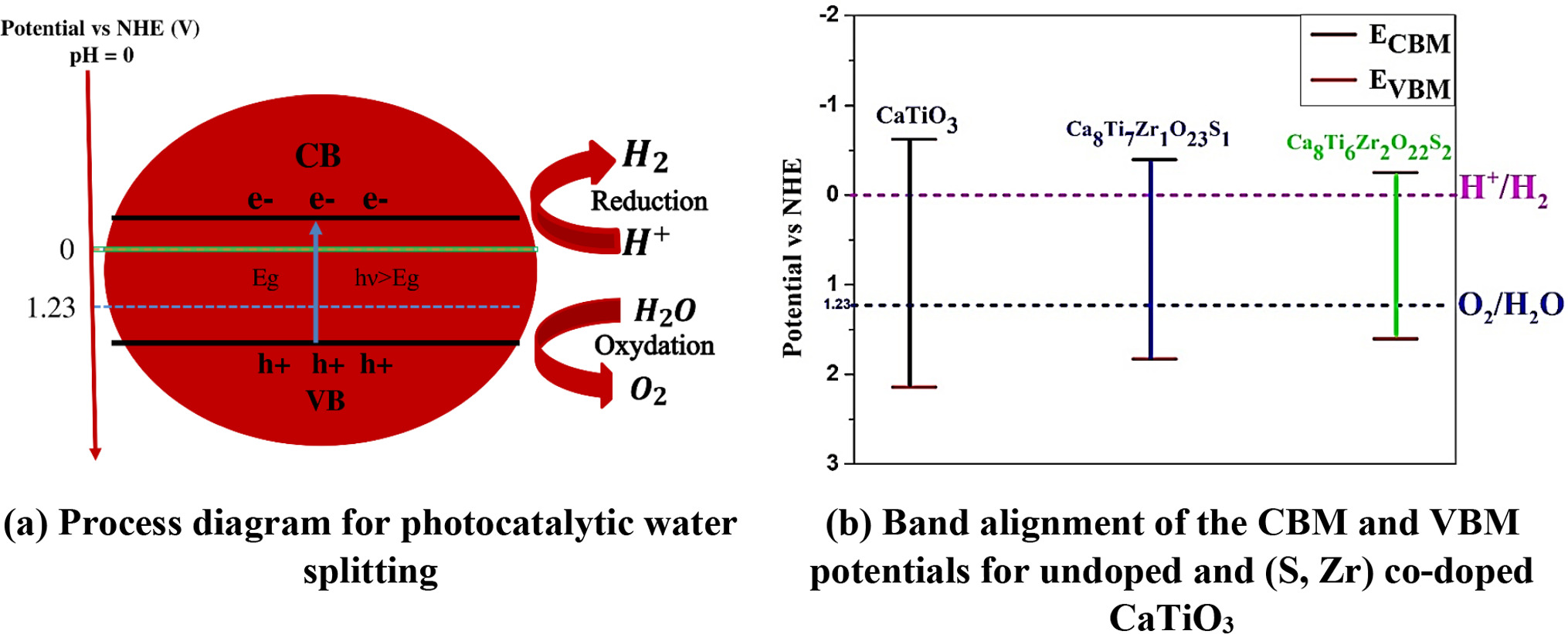https://doi.org/10.1140/epjb/s10051-025-01004-2
Research - Condensed Matter
Boosting the photocatalytic hydrogen production via the S/Zr co-doping in a CaTiO3 perovskite: first-principles study of the optoelectronic, thermodynamic, and photocatalytic
1
Engineering and Applied Physics Team (EAPT), Superior School of Technology, Sultan Moulay Slimane University, Beni Mellal, Morocco
2
The Moroccan Association of Sciences and Techniques for Sustainable Development (MASTSD), Beni Mellal, Morocco
3
Laboratory of Research in Physics and Engineering Sciences, Polydisciplinary Faculty, Sultan Moulay Slimane University, Beni Mellal, Morocco
Received:
16
May
2025
Accepted:
15
July
2025
Published online:
31
July
2025
Recent advancements in photocatalysis research have mostly concentrated on the development of effective materials to enhance water splitting and the production of hydrogen. This work used density functional theory (DFT) to investigate the structural, optoelectronic, thermodynamic characteristics, and redox band edges of undoped and (S, Zr) co-doped CaTiO3. The initial structural optimization results indicate that undoped and (S, Zr) co-doped CaTiO3 have negative formation energies, signifying their thermodynamic stability. Furthermore, thermodynamic analysis indicates a significant change in the Grüneisen parameter, Debye temperature, entropy, and heat capacities due to co-doping, showing the change of lattice anharmonicity and vibrational characteristics with variations in temperature and pressure. Optoelectronic calculations show that undoped CaTiO3 has an indirect band gap of 2.77 eV. In contrast, co-doping with S and Zr results in direct band gaps of 2.22 eV for  and 1.85 eV for
and 1.85 eV for  , which reduces the band gap and enhances visible light absorption and optical conductivity. Furthermore, the analysis of the valence and conduction band edge positions (EVB and ECB) of Zr- and S-co-doped CaTiO3 indicates that the material satisfies the thermodynamic requirements for water splitting, underscoring its potential as an efficient photocatalyst. Notably, the observed variations in electronic and thermodynamic properties with increasing dopant concentration reveal a nonlinear trend, suggesting a complex interplay between dopant interactions and host lattice distortions. These findings suggest that co-doped materials exhibit promising properties for renewable energy applications, particularly solar-driven photocatalytic hydrogen production, photovoltaic devices, and optoelectronics, due to their enhanced visible light absorption.
, which reduces the band gap and enhances visible light absorption and optical conductivity. Furthermore, the analysis of the valence and conduction band edge positions (EVB and ECB) of Zr- and S-co-doped CaTiO3 indicates that the material satisfies the thermodynamic requirements for water splitting, underscoring its potential as an efficient photocatalyst. Notably, the observed variations in electronic and thermodynamic properties with increasing dopant concentration reveal a nonlinear trend, suggesting a complex interplay between dopant interactions and host lattice distortions. These findings suggest that co-doped materials exhibit promising properties for renewable energy applications, particularly solar-driven photocatalytic hydrogen production, photovoltaic devices, and optoelectronics, due to their enhanced visible light absorption.
Copyright comment Springer Nature or its licensor (e.g. a society or other partner) holds exclusive rights to this article under a publishing agreement with the author(s) or other rightsholder(s); author self-archiving of the accepted manuscript version of this article is solely governed by the terms of such publishing agreement and applicable law.
© The Author(s), under exclusive licence to EDP Sciences, SIF and Springer-Verlag GmbH Germany, part of Springer Nature 2025
Springer Nature or its licensor (e.g. a society or other partner) holds exclusive rights to this article under a publishing agreement with the author(s) or other rightsholder(s); author self-archiving of the accepted manuscript version of this article is solely governed by the terms of such publishing agreement and applicable law.





